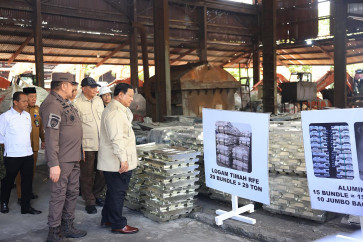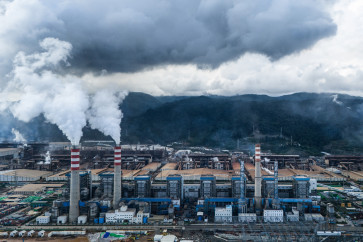Popular Reads
Top Results
Can't find what you're looking for?
View all search resultsPopular Reads
Top Results
Can't find what you're looking for?
View all search resultsThe emissions mirage: Understanding what we count and miss
The companies that are starting to count their emissions today are the ones that will remain competitive tomorrow.
Change text size
Gift Premium Articles
to Anyone
 Nickel smelter chimneys spew a column of emissions on July 7, 2024, into the air above the Indonesia Weda Bay Industrial Park in Lelilef, North Maluku. Despite coal making up 67 percent of Indonesia’s 2023 energy mix, the country is shifting toward cleaner sources, impacting the nickel industry, which is vital for electric vehicle (EV) batteries. (AFP/Azzam Risqullah)
Nickel smelter chimneys spew a column of emissions on July 7, 2024, into the air above the Indonesia Weda Bay Industrial Park in Lelilef, North Maluku. Despite coal making up 67 percent of Indonesia’s 2023 energy mix, the country is shifting toward cleaner sources, impacting the nickel industry, which is vital for electric vehicle (EV) batteries. (AFP/Azzam Risqullah)
“If we really wanted to count every emission, we could put a sensor on every chimney, vehicle and rice paddy. But how many millions of sensors would that take. And more importantly, who would pay for them?”
That question gets to the heart of an issue we rarely talk about, while businesses and governments alike are rushing to decarbonize, the foundation of climate action, which is our ability to measure emissions, is far from perfect. Yet, this imperfect foundation is what shapes carbon taxes; net-zero targets; environment, social and governance (ESG) disclosures; and climate claims on everything from food labels to investment portfolios.
Across the globe, companies are being asked to “know their numbers”. How much do you emit? How much will you cut? How quickly can you do it? But the problem is that not all emissions are equally visible, equally measurable or equally accounted for.
Some emissions are relatively easy to calculate. For example, if a manufacturing plant burns diesel, it can estimate emissions using fuel purchase records and standard emission factors. These are known as Scope 1 emissions, or direct emissions from sources a company owns or controls.
Others are trickier. For example, Scope 2. The emission itself comes from purchased electricity, which means it depends on where your energy comes from, while the carbon footprint of a kilowatt-hour can vary dramatically. Let us take an example of Indonesia’s grid, it is heavily reliant on coal in certain regions, meaning electricity use there is more carbon-intensive than in places with a greener mix.
Afterward, there is Scope 3, the elephant in the emissions room. It includes everything upstream and downstream, starting with the emissions that come from the materials you buy, transporting them, using your products and even dealing with them after disposal. For most companies, Scope 3 accounts for over 70 percent of total footprint, and yet, it is often the least measured.
No one is expecting perfection because emission inventories are estimates; built from a mix of real measurements, activity data (like fuel use or kilometers traveled) and standardized emission factors. Even the best estimates face big challenges.
Your Opinion Matters
Share your experiences, suggestions, and any issues you've encountered on The Jakarta Post. We're here to listen.
Thank you
Thank you for sharing your thoughts. We appreciate your feedback.


















